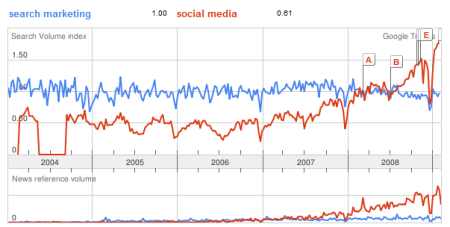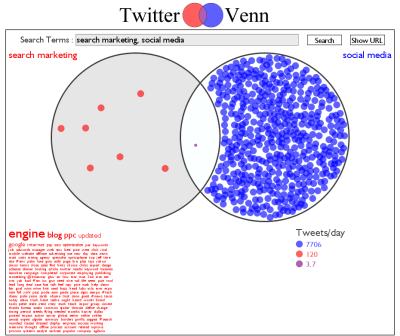
Social media is hot, just take a look at Google Trends to see the comparison between topics like “search marketing” being eclipsed by “social media” in terms of search volume and news references – at least according to Google. Along with all that “hotness”, there’s good and bad when it comes to the way companies are beginning to engage social media channels.

On Twitter, the difference between mentions of “search marketing” and “social media” are even more pronounced. Of course this is by no means a formal assessement, but it gives you an idea of what people on the web are paying attention to and in some cases, what they expect.
Most people learn about new things in terms of what they already know. Any number of companies have taken this approach to heart and entered the social media world oblivious to the formal and unwritten community rules and treating social channels simply as another dumping ground for current advertising assets. Don’t get me wrong, there’s some amazing digital creative that’s being produced (TV commercials and ads) that are well received on sites like YouTube, Digg and StumbleUpon.
But for the most part, many marketers are not exactly sure about the difference between best and worst practices when it comes to participation with the social web where intentions are commercially motivated. Identifying best and worst practics is a work in progress of course, as communities develop, grow and change. It’s best to start out with the basics that will hold true regardless of these changes:
Social Media Best Practices:
- Start with a plan, not tactics. Research and build a Social Media Roadmap involving: Audience, Objectives, Strategy, Tactics, Tools/Technology and Metrics.
- “Give to get” – Successful social media marketing programs involve listening and participation. That participation centers around giving value before expecting anything in return. This is not “sales” as you know it. But companies can definitely increase sales as a result.
- Commit resources & time to be successful or you may very well fail. It’s important to forecast labor hours, who, what, when, how and where with the intention of succeeding, not just experimenting. If a social media effort is successful, scalability will be an even bigger issue if you don’t plan for it. Hiring a community manager for example, may not be justified when a social media monitoring program is started or with a new company, but a job req and understanding of the role should be ready in case it’s called for.
- Be transparent with intentions & your identity or you may alienate the very audiences you’re trying to connect with. Objectives, strategy and doing your homework about a community should make it pretty obvious what types of commercial messages are appropriate. Being transparent about intentions might come in the form of stating a purpose: “Brand XYZ has created this Facebook page to help consumers make better choices about Topic XYZ”. It’s fine if goals are to increase sales, but participation should be focused on providing the kind of value that facilitates sales – not attempting to make sales directly. When is the last time you purchased something other than a virtual cupcake on Facebook?
- Understand, you do not control the message. Old habits die hard and there’s a tendency to want to treat social media participation like advertising where the ability to control messaging is the norm. Once information or media is available on the social web, people will inevitably mash it up, stretch it, pull it and reshape it according to their interests. Brands need to protect their identities, copyright and intellectual property for sure, but rather than “controlling the message” marketers should encourage the mashup and creativity.
- Welcome participation, feedback and co-creation. As comfort levels rise with social web participation, companies will see opportunties to encourage participation with communications, especially with brand evangelists. Developing relationships and community within social communities on the web can facilitate buy in, provide invaluable feedback and crowdsourcing opportunities.
- Metrics should roll up to objectives and objectives should be relevant to the channel. More than a few companies see evidence of other social media efforts ranging from Superbowl commercials on YouTube to social participation during and after President Obama’s campaign, and “want that too”. Direct marketing is the lens through which many social media efforts are first viewed, with a tendency to focus on action “A” resulting in “B” outcome. Social media marketing is more like public relations than direct marketing. It’s more like providing resource “A” results in “action “B” that influences outcome “C”. Metrics for success need to consider the pre-goal performance indicators like number of “friends”, comments, links, etc as well as commercial outcomes influenced by social media participation.
Social Media Worst Practices:
- Being fake in any way isn’t good for anyone on the social web. Early on, companies like Walmart and Sony (via their PR firms) tried to fake their way into making consumers believe sites like the Sony PSP blog or the Walmarting Across America blog were authored by impartial brand evangelists, when it wasn’t that at all. Both Sony and Walmart have learned from those mistakes and now have social media sites that follow many of the best practices above. Some say failure with social media is a sort of “rite of passage”.
- Not listening. How can you learn anything if information is only flowing one way? Listening is really the most important step in learning about social communities on the web. It’s important just starting out and even more so on an ongoing basis to monitor conversations, sentiment about brands and identifying influentials to engage. Lucky for companies, there are abundant social media monitoring tools to choose from.
- Being oblivious to formal & unwritten social rules. It pays to lurk a bit before participation with social communities, especially when you have commercial intentions. Aspire to “speak like a native” when embarking on social media journey to improve your brand visibility and to encourage relationships. Social networking, news and media sharing sites all have Terms of Service guidelines, but the community itself will have guidelines for behavior that can only be understood by observing and participating. Ignoring these guidelines risks alienation by the community.
- Being pushy or overtly salesy in messaging and communications and expecting traditional marketing outcomes are common behaviors by companies that see social media communities simply as content distribution channels for existing marketing programs. Overt commercial messages, especially sales solicitations are outright tabu in most social communties. A social environment amongst “friends” and likeminded individuals isn’t going to accept interruptive messaging. Think of barging into a conversation at a party trying to sell something to people who are talking about their favorite movies and sharing baby pictures – and the disdain that behavior would encourage. Provide the kind of information that facilitates choices that lead to sales, and you’ll go a lot further.
- Approaching social media channels as silos – Many companies approach social media via individual web sites rather than as a collaborative effort. An example would be a company that starts a blog within one division and another that starts something on Facebook and yet another creates a group on LinkedIn or Ning. Not working together is inefficient and can create mixed messages for consumers that participate in more than one social media destination for the brand.
Update 07/2009 thanks to Hillary Danni Davis
- Not staffing appropriately
Actively listening and building relationships with communities is a full-time job. Also, its imperative to ensure community managers have the skill sets needed to articulate their objectives for social media in addition to utilizing tools that will resonate with their audience.
- Not having a mechanism to assess ROI
CEOs that ultimately give the green light to pursue social media marketing are concerned with the bottom line. Its essential that a social media strategy includes mechanisms to assess business value. It might be a value placed on increased product awareness, solid sales leads or cost savings due to a reduction in support staff due to social media tools. ROI is easier to obtain if there is a stated goal for the social media campaign. Regardless of how value is determined, social media needs to be validated as a profitable marketing channel.
Learning from companies what they think of social media as a topic and opportunity over the past few years has been enlightening. Our digital marketing and public relations agency gets to talk to a substantial number of companies each month that need help making sense of where social media might fit within overall marketing and PR efforts. Those conversations vary, but an increasing number of client side marketers clearly aware of the social media marketing fundamentals.
In those cases, companies simply want help from someone that has the experience to guide them in creating a social media strategy, specific supporting tactics and dealing with measurement issues. Other companies really have no idea how to proceed and need a focus on education and an audit that will help them create a social media roadmap before getting into specific programs.
What’s encouraging is that more companies are looking more seriously at the challenges and opportunities of social media participation. Others understand that social media is not a destination, but rather an indication of consumer behaviors aided by technology. Successful social media marketing isn’t about the tools, it’s about the people.
If nothing else, remember that social media is about the C’s: Conversation, Connections, Community, Consumer, Control, Creative, Collaboration and Content. Do: listen, be transparent about your intentions, “Give to Get” and have a plan. Don’t: Be fake, interruptive and focus only on short term sales.
Need more data on justifying social media marketing in your organization? Check out the new report from Marketing Sherpa: “What Works and What Doesn’t in Social Media Marketing and PR“.


